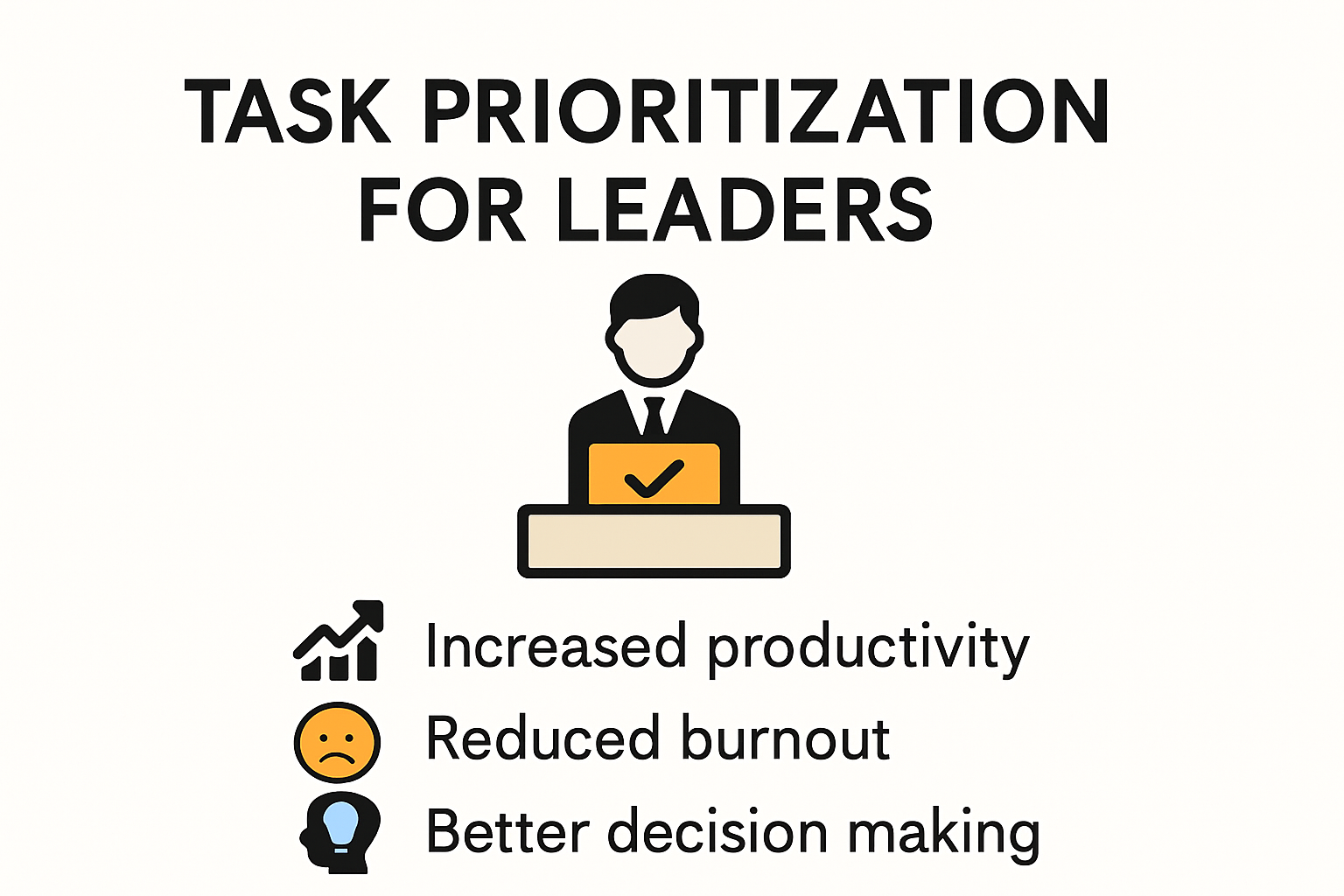Task lists keep growing, but leaders in 2025 face a new problem. Research shows that companies using strong prioritization frameworks have seen productivity soar by up to 30 percent. Surprised? Many still think working more hours is the answer. The real secret is not about getting more done, but knowing exactly which tasks matter most—this is where modern leadership takes a sharp turn.
Table of Contents
- Why Task Prioritization Drives Success
- Key Benefits For Teams And Businesses
- Effective Prioritization Strategies In 2025
- Common Challenges And How To Overcome Them
Quick Summary
| Takeaway | Explanation |
|---|---|
| Task Prioritization Enhances Success | Effective task prioritization is a strategic approach that improves organizational performance and team productivity by focusing on high-impact activities. |
| Utilize Frameworks Like the Eisenhower Matrix | Leaders can categorize tasks based on urgency and importance to allocate resources more effectively and prevent organizational drift. |
| Implement the Pareto Principle | Concentrating on the 20% of tasks that yield 80% of results can dramatically enhance productivity and strategic impact. |
| Conduct Comprehensive Time Audits | By tracking time spent on activities, leaders can identify inefficiencies and realign schedules for maximum productivity. |
| Address Workload Challenges Strategically | To manage overwhelming workloads and conflicting priorities, leaders should break down complex tasks and establish clear objectives. |
Why Task Prioritization Drives Success
Leaders in 2025 recognize that task prioritization is not just a management technique but a critical strategic approach that separates successful organizations from struggling ones. Effective task prioritization transforms how leaders allocate time, energy, and resources, directly impacting organizational performance and team productivity.

The Strategic Power of Focused Effort
Task prioritization enables leaders to concentrate on high-impact activities that drive meaningful results. According to research from the National Institutes of Health, leaders who implement structured prioritization strategies can significantly enhance their team’s efficiency and strategic outcomes.
The Eisenhower Matrix emerges as a powerful framework for decision making. Forbes research reveals that this method helps leaders categorize tasks based on their urgency and importance, enabling more strategic resource allocation. By distinguishing between critical tasks that require immediate attention and those that can be delegated or eliminated, leaders prevent organizational drift and maintain laser-focused momentum.
Preventing Team Burnout Through Strategic Focus
Prioritization is not just about doing more work but about doing the right work. Research from ResearchGate demonstrates that leaders who master prioritization can significantly reduce team burnout by preventing unnecessary workload escalation.
This approach involves:
- Identifying high-value tasks that directly contribute to organizational goals
- Eliminating low-impact activities that consume valuable time and resources
- Creating clear task hierarchies that provide team members with strategic direction
By implementing these strategies, leaders create an environment where team members understand their priorities, feel empowered, and can direct their energy toward meaningful work. This not only improves productivity but also enhances overall job satisfaction and organizational resilience.
Prioritization in 2025 is about strategic agility. It requires leaders to be dynamic, continuously reassessing task importance, understanding shifting organizational needs, and reallocating resources with precision. Those who master this skill will lead their teams with exceptional clarity and purpose, transforming potential chaos into structured, goal-oriented progress.
To clarify different prioritization strategies mentioned throughout the content, here’s a comparison table summarizing their key features and benefits:
| Strategy | Key Features | Benefits |
|---|---|---|
| Eisenhower Matrix | Categorizes tasks by urgency/importance | Prevents drift, improves resource allocation |
| Pareto Principle (80/20 Rule) | Focus on vital few tasks yielding biggest results | Maximizes productivity, strategic impact |
| Comprehensive Time Auditing | Tracks and analyzes time spent on activities | Identifies inefficiencies, boosts productivity |
| Task Decomposition & Hierarchical Obj. | Breaks down complex tasks, outlines clear priorities | Reduces overwhelm, clarifies direction |
Key Benefits for Teams and Businesses
Task prioritization is a transformative strategy that delivers substantial advantages for teams and businesses in 2025, offering more than just incremental improvements in workflow management. By systematically organizing and focusing organizational efforts, leaders can unlock significant performance potential and create a more resilient, adaptive work environment.
Dramatic Productivity Enhancement
Structured prioritization practices have proven to be a powerful mechanism for driving organizational efficiency. Research from Flevy reveals that businesses implementing robust prioritization frameworks can experience productivity improvements up to 30%, a remarkable leap that directly translates to competitive advantage.
The productivity gains emerge from several critical mechanisms:
- Focused Resource Allocation: Directing energy toward high-impact tasks
- Reduced Decision Fatigue: Providing clear strategic guidelines for task selection
- Minimized Unnecessary Work: Systematically eliminating low-value activities

These strategies ensure that teams are not just working harder, but working smarter, with a laser focus on activities that generate meaningful organizational outcomes.
Strategic Decision Making and Organizational Agility
Leadership research from Today’s Leader highlights that effective prioritization fundamentally transforms decision-making processes. By creating a structured approach to task management, organizations develop enhanced strategic agility, allowing them to rapidly adapt to changing market conditions and emerging opportunities.
Key decision-making improvements include:
- Faster Response Times: Quick identification of critical tasks
- Enhanced Resource Flexibility: Ability to reallocate efforts swiftly
- Improved Organizational Alignment: Ensuring all team efforts connect to core strategic objectives
Businesses that master prioritization create a culture of intentional progress, where every action is carefully considered and strategically positioned for maximum impact. This approach eliminates organizational waste and creates a more responsive, dynamic workplace environment.
Moreover, prioritization serves as a critical tool for managing team energy and preventing burnout. By providing clear guidance on task importance and creating realistic workload expectations, leaders can maintain high performance while protecting team well-being.
In 2025, task prioritization is no longer optional but a fundamental leadership competency. Organizations that embrace this approach will distinguish themselves through superior execution, strategic clarity, and the ability to consistently deliver exceptional results in an increasingly complex business landscape.
To provide a snapshot of the organizational benefits discussed, here is a summary table of key results and effects of structured task prioritization:
| Benefit | Description | Impact |
|---|---|---|
| Productivity Improvement | Up to 30% gain with strong frameworks | Competitive advantage |
| Reduced Decision Fatigue | Clear guidelines simplify choices | Faster, more confident decisions |
| Minimized Unnecessary Work | Low-value activities systematically removed | Higher efficiency, less burnout |
| Enhanced Strategic Agility | Structured task management increases adaptability | Quick response to change |
| Improved Team Clarity & Alignment | Clear priorities and direction for all members | Higher morale, better results |
Effective Prioritization Strategies in 2025
As business dynamics continue to evolve, leaders must adopt sophisticated prioritization strategies that go beyond traditional time management approaches. In 2025, successful prioritization requires a holistic, data-driven methodology that integrates strategic thinking, technological tools, and psychological insights.
The Pareto Principle and Strategic Focus
Research from IT Leadership highlights the critical importance of the Pareto Principle in modern task management. By identifying and concentrating on the 20% of tasks that generate 80% of organizational results, leaders can dramatically enhance productivity and strategic impact.
Implementing the Pareto Principle involves:
- Detailed Task Analysis: Rigorously evaluating each task’s potential impact
- Strategic Task Mapping: Categorizing activities based on their strategic value
- Continuous Reassessment: Regularly updating priorities as organizational goals shift
This approach transforms prioritization from a reactive process to a proactive strategic tool, enabling leaders to consistently focus on high-leverage activities that drive meaningful progress.
Comprehensive Time Auditing and Performance Optimization
The Almithaq Institute recommends conducting comprehensive time audits as a powerful strategy for improving organizational efficiency. This method involves meticulously tracking and analyzing how time is currently spent, identifying inefficiencies, and strategically realigning schedules to maximize productivity.
Key components of an effective time audit include:
- Detailed Time Tracking: Documenting all activities with precision
- Performance Benchmarking: Comparing time allocation against strategic objectives
- Systematic Optimization: Developing targeted strategies to eliminate time waste
Time auditing provides leaders with a granular understanding of their team’s operational dynamics, enabling them to make data-driven decisions about resource allocation and task prioritization.
In 2025, successful prioritization transcends simple task management. It requires a sophisticated approach that combines technological insights, strategic thinking, and a deep understanding of organizational dynamics. Leaders who master these advanced prioritization strategies will create more agile, efficient, and competitive organizations.
The future of leadership is not about doing more work, but about doing the right work with exceptional precision and strategic intent. By embracing these advanced prioritization techniques, leaders can transform their teams from reactive performers to proactive innovators, consistently delivering exceptional results in an increasingly complex business environment.
Common Challenges and How to Overcome Them
Task prioritization, while critical for organizational success, presents numerous complex challenges for leaders in 2025. Understanding these obstacles and developing strategic approaches to navigate them becomes paramount for maintaining productivity and team effectiveness.
Navigating Overwhelming Workloads and Conflicting Priorities
BMC Network research reveals that leaders frequently struggle with overwhelming workloads and conflicting priorities that can paralyze decision-making processes. These challenges emerge from multiple organizational dynamics, including unclear objectives, competing departmental goals, and rapidly changing business environments.
Effective strategies to address these challenges include:
- Decomposing Complex Tasks: Breaking large initiatives into manageable components
- Establishing Clear Hierarchical Objectives: Creating transparent priority frameworks
- Implementing Stakeholder Alignment Meetings: Resolving priority conflicts through collaborative discussions
By systematically addressing these elements, leaders can transform potential chaos into structured, purposeful action.
Leadership Transition and Adaptation Challenges
Research from the National Institutes of Health highlights that new leaders often experience significant uncertainty and emotional challenges when transitioning into leadership roles. These challenges directly impact their ability to effectively prioritize tasks and manage team expectations.
Critical adaptation strategies include:
- Building Robust Support Networks: Connecting with experienced mentors
- Engaging in Continuous Learning: Participating in leadership development programs
- Developing Personal Prioritization Frameworks: Creating personalized systems for task management
Successful leaders recognize that prioritization is not just about task management but about developing a strategic mindset that allows for flexible, responsive leadership.
Modern leadership demands more than traditional management techniques. It requires a holistic approach that balances strategic thinking, emotional intelligence, and technological adaptability. Leaders who master these skills can transform potential challenges into opportunities for organizational growth and personal development.
Prioritization in 2025 is not a static process but a dynamic, continuously evolving strategy. By embracing complexity, remaining adaptable, and maintaining a clear focus on organizational objectives, leaders can navigate even the most challenging prioritization landscapes with confidence and precision.
Frequently Asked Questions
What is task prioritization and why is it important for leaders in 2025?
Task prioritization is the process of determining the order in which tasks should be tackled based on their importance and urgency. It is crucial for leaders in 2025 because it enhances organizational performance, significantly boosts productivity, and helps prevent burnout by focusing on high-impact activities.
How can leaders effectively prioritize tasks?
Leaders can effectively prioritize tasks by using frameworks such as the Eisenhower Matrix to categorize tasks based on urgency and importance, implementing the Pareto Principle to focus on the 20% of tasks that yield 80% of results, and conducting comprehensive time audits to identify inefficiencies.
What are the key benefits of task prioritization for teams?
The key benefits of task prioritization for teams include increased productivity (potentially up to 30%), reduced decision fatigue, minimized unnecessary work, improved organizational agility, and enhanced team clarity and morale due to well-defined priorities.
What challenges do leaders face in task prioritization, and how can they overcome them?
Leaders often face challenges such as overwhelming workloads and conflicting priorities. To overcome these, they can break down complex tasks into manageable components, establish clear objectives, conduct stakeholder alignment meetings, and develop personal prioritization frameworks.
Take Control of Task Prioritization with Gammatica
Are you facing growing to-do lists and uncertain priorities, just like today’s leaders discussed in our article? Leaders in 2025 are overwhelmed by complex workloads, constant distractions, and multiple urgent requests. The real bottleneck is not just about staying busy but about having systems that identify and elevate the most important tasks. Imagine how your team could thrive if you could automate repetitive work, focus only on high-impact actions, and consistently prevent burnout by cutting out the noise.

Now is the time to turn smart frameworks like the Eisenhower Matrix and Pareto Principle into daily habits. Gammatica.com leverages AI to highlight urgent and impactful tasks, automate routine processes, and give you time back every week. Use built-in Kanban boards, ensure meeting coordination with Zoom integration, and analyze real team productivity through time tracking. Stop letting your team drift. Get started on Gammatica.com and build your own high-performance prioritization engine. See how much more you can achieve today.



